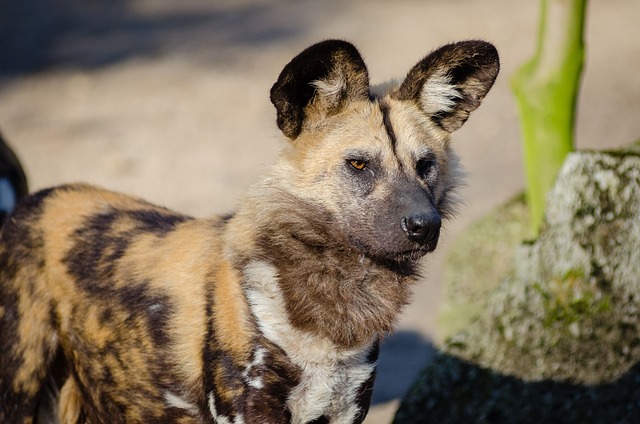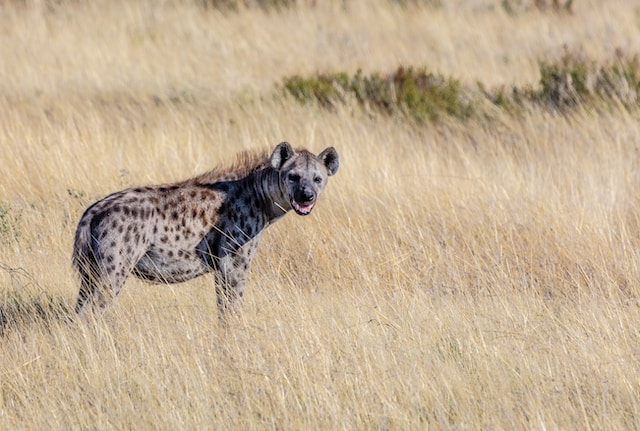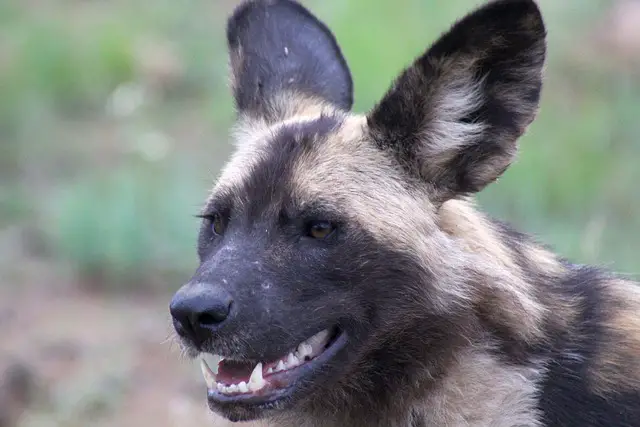African wild dogs are slender and agile with large ears for communication purposes while hyenas have a sturdy build with strong jaws made to crush bones. Wild dogs hunt cooperatively as a pack whereas Hyenas are opportunistic omnivores known to steal food from other predators including lions.
African Wild Dogs
(Image by Pexels from Pixabay )

African wild dogs, also known as painted wolves, are one of the most social species in the animal kingdom. They live in packs that can range from 6 to 20 individuals and have a complex social hierarchy.
One of the unique characteristics of African wild dogs is their coat pattern. Each individual has its own distinctive markings, making it easy for pack members to identify each other from afar.
These predators are incredibly efficient hunters and have a success rate of up to 80% when hunting in groups. They use their keen senses and stamina to chase down prey such as antelopes or gazelles until they tire out.
Unlike other predators like lions or hyenas that scavenge for food, African wild dogs only eat fresh kills. Their diet mainly consists of meat but they may occasionally eat fruits or vegetables too.
Sadly, these amazing animals face numerous threats including habitat loss and human persecution due to negative perceptions about them being “vermin”. It’s important that we continue to raise awareness about the importance of protecting these beautiful creatures so future generations can continue admiring them in their natural habitats.
Hyenas
(Photo by Alan J. Hendry on Unsplash )

Hyenas are fascinating creatures that have been misunderstood and shrouded in myth for centuries. They belong to the family Hyaenidae, which includes four species – spotted, brown, striped, and aardwolves. Hyenas are known for their distinctive vocalizations often heard during the night; these sounds can be mistaken for laughter or screams.
Hyenas are social animals that live in groups called clans consisting of up to 80 individuals. The clan is led by a dominant female who is larger than her male counterparts and makes all major decisions regarding hunting and territorial defense.
Hyenas have a reputation as scavengers; however, they also actively hunt prey such as wildebeest, zebras, antelopes and even buffalo! Interestingly enough though hyena’s digestive system allows them to digest bones while other carnivores cannot (i.e lion).
These intelligent animals play an important role in maintaining balance within the ecosystem through both predation and scavenging. In some cultures like Tanzania’s Masaai tribes consider hyenas spiritual protectors from evil spirits!
Hyenas represent more than just scavenging beasts – they form complex societies with unique abilities essential for their survival!
Difference in Appearance
African wild dogs typically have a lean build with long legs. Their fur is short and colorful, usually featuring a mix of black, brown, white, and yellow patches on their body. Each individual dog has its unique pattern of spots which makes it easy to identify one from another. They also have large rounded ears that help them hear prey from great distances.
Hyenas, on the other hand, look quite different than African wild dogs. They have rounder bodies with shorter legs compared to Wild Dogs . Hyena’s coat is shaggier and ranges from grayish-brown to reddish-brown or nearly black depending on species.
Their head is more massive than the Wild Dogs ,and they have powerful jaws for crushing bones.
While both animals are carnivores that share some similarities in terms of behavior and diet; they each possess distinct physical characteristics that make them easy to differentiate when observed closely.
Difference in Behavior
African wild dogs and hyenas have vastly different behaviors. African wild dogs are social animals that live in packs of up to 20 individuals, while hyenas tend to be more solitary or live in small groups.
One notable behavior difference is their hunting style. African wild dogs hunt by chasing down prey, working together as a pack to take down larger animals like antelopes and wildebeests. They also have incredible stamina that allows them to outlast their prey during long chases.
Hyenas, on the other hand, are scavengers but they’re not above hunting for themselves too. They have an impressive jaw strength that can crush through bones which gives them an advantage when it comes to eating carrion left behind by other predators.
Another interesting behavior difference is how they communicate with one another. African wild dogs use vocalizations such as yips and whines, which help them coordinate during hunts and stay connected within their pack. Hyenas communicate with each other using various vocalizations including whoops, growls, grunts and giggles.
African wild dogs rely on teamwork and communication skills learned from living in packs while hyenas adapt well alone or in small groups relying heavily on their strong jaws for survival
Difference in Diet
African wild dogs and hyenas have different diets, which reflect their hunting behavior. African wild dogs are known to hunt in packs, often chasing down prey for long distances. Their diet mainly consists of antelopes, but can also include zebras, warthogs and even smaller mammals such as gazelles and hares.
On the other hand, hyenas are scavengers that feed on carrion or leftovers from other predators’ kills. They are also capable hunters who can take on large prey such as wildebeest or buffalo when necessary. However, unlike African wild dogs who rely on speed and endurance during their hunts, hyenas use brute force to overpower their prey with powerful jaws.
Even though both species may occasionally scavenge for food or steal each other’s meals, it’s clear that they have adapted distinct diets according to their unique ways of hunting. These differences enable them to coexist without competing directly for resources in the same ecological niche.
African wild dogs Vs. Hyenas – Key differences
Firstly, their appearances differ significantly. African wild dogs have a slender build with long legs, while hyenas have a stocky body structure with shorter legs.
Another significant difference is in their behavior. African wild dogs live in packs and work together to hunt prey, while hyenas tend to be solitary scavengers that will often steal food from other predators. This means that they have different social structures and hunting methods.
Their diets also vary greatly – while both are carnivores, hyenas are known for feeding on carrion or taking down weaker animals solo or as part of a group effort, where the larger female dominates her male counterparts; whereas the wild dog cooperatively hunts medium size preys such as antelopes by using stamina rather than stealth tactics.
Despite some similarities in habitat and diet preferences since both animals coexist within same areas of savannahs and grasslands habitats across Africa although they avoid each others’ territories when possible- the differences between African wild dogs and hyenas make them unique from one another in many ways.
Do wild dogs fight hyenas?
While these two species are known to be competitors in some areas, their interactions can vary depending on different factors.
In some cases, African wild dogs and hyenas will avoid each other altogether by occupying different territories or hunting at separate times of day. However, when they do overlap in space and time, there can be conflicts.
One thing that’s worth noting is that while African wild dogs may appear smaller than hyenas, they are actually highly efficient hunters with strong social bonds. They have been known to successfully defend their kills against larger predators like lions and spotted hyenas.
That being said, hyenas also have impressive physical capabilities and should not be underestimated. Their powerful jaws and ability to work together as a team make them formidable opponents for any predator.
While it’s certainly possible for wild dogs to fight hyenas under certain circumstances, there is no one-size-fits-all answer to this question. The outcome of such an encounter would depend on many variables including the animals’ sizes, numbers, motivations and levels of aggression at that moment in time.
What dog is closest to a hyena?
While hyenas and dogs may look somewhat similar at first glance, they are actually quite distinct in terms of their evolutionary history and genetic makeup.
One key thing to note is that hyenas are not technically dogs at all – they belong to their own unique family called Hyaenidae. Dogs, on the other hand, belong to the family Canidae. This means that while there may be some superficial similarities between the two groups (such as their long snouts or sharp teeth), they have significant differences when it comes down to their physiology and behavior.
That being said, if we had to choose a particular breed of dog that was most similar in appearance or behavior to a hyena, one option might be the Basenji. These small hunting dogs from Africa share some traits with hyenas such as upright ears and short fur coats; however, beyond these physical characteristics any further connection would become fairly tenuous.
Ultimately though, trying too hard find parallels between these two animals can obscure how truly unique each species is on its own terms!








